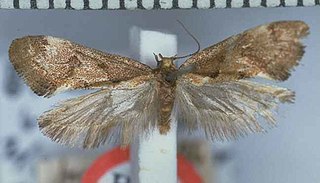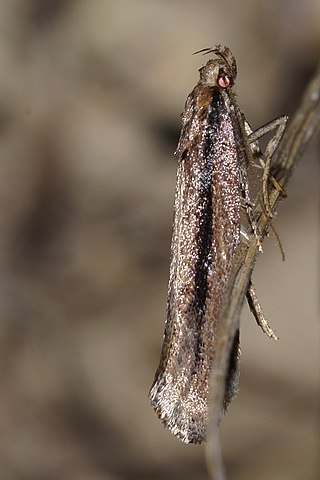
Falcaria lacertinaria, the scalloped hook-tip, is a moth of the family Drepanidae. The species was first described by Carl Linnaeus in his 1758 10th edition of Systema Naturae It is found in Europe and Anatolia then east to Eastern Siberia.

Ypsolopha scabrella, the wainscot hooktip or wainscot smudge, is a moth of the family Ypsolophidae. The species was first described by Carl Linnaeus in 1761. It is found in Europe, China, Russia, Asia Minor and mideast Asia.
Xyroptila peltastes is a moth of the family Pterophoridae. It is found in Australia.
Hexadactilia civilis is a moth of the family Pterophoridae. It is found in Queensland, Australia.

Hexadactilia trilobata is a moth of the family Pterophoridae described by Thomas Bainbrigge Fletcher in 1910. It is found in Australia in Queensland and New Guinea.
Ypsolopha barberella is a moth of the family Ypsolophidae. It is known from the United States, including Arizona, Nevada and Utah.
Ypsolopha oliviella is a moth of the family Ypsolophidae. It is known from the United States, including Arizona.
Ypsolopha arizonella is a moth of the family Ypsolophidae. It is known from the United States, including Arizona.
Ypsolopha striatella is a moth of the family Ypsolophidae. It is known from the United States, including California.
Ypsolopha delicatella is a moth of the family Ypsolophidae. It is known from the United States, including Arizona and California.
Ypsolopha nella is a moth of the family Ypsolophidae. It is known from the United States, including Arizona and Utah.
Ypsolopha walsinghamiella is a moth of the family Ypsolophidae. It is known from the United States, including Arizona and California.
Ypsolopha vintrella is a moth of the family Ypsolophidae. It is known from the United States, including Arizona and California.

Ypsolopha vittella, the elm autumn moth, is a moth of the family Ypsolophidae. It is found from Europe through Siberia to Japan, including China, Asia Minor and mideast Asia. The habitat consists of woodlands and copses.
Ypsolopha buscki is a moth of the family Ypsolophidae. It is known from the United States, including Arizona.
Epermenia trileucota is a moth in the family Epermeniidae. It was described by Edward Meyrick in 1921. It is found in Australia, where it has been recorded from South Australia.
Scrobipalpa chersophila is a moth in the family Gelechiidae. It was described by Edward Meyrick in 1909. It is found in South Africa.
Stenoma platyterma is a moth of the family Depressariidae. It is found in Guyana.

Tingena brachyacma is a species of moth in the family Oecophoridae. It is endemic to New Zealand and has been found in the south of the South Island. This species inhabits open swamps, native forest and scrubland and has been collected amongst Leptospermum. The adults of the species are on the wing in November and December.

Atomotricha versuta is a moth in the family Oecophoridae first described by Edward Meyrick in 1914. It is endemic to New Zealand and has been observed in both the North and South Islands. The adults of the species are variable in appearance but the three principal variteis are connected b intermediate forms. The female of the species is brachypterous and is incapable of flight. Both the adult male and female have been observed resting on fences during cold winter nights.





